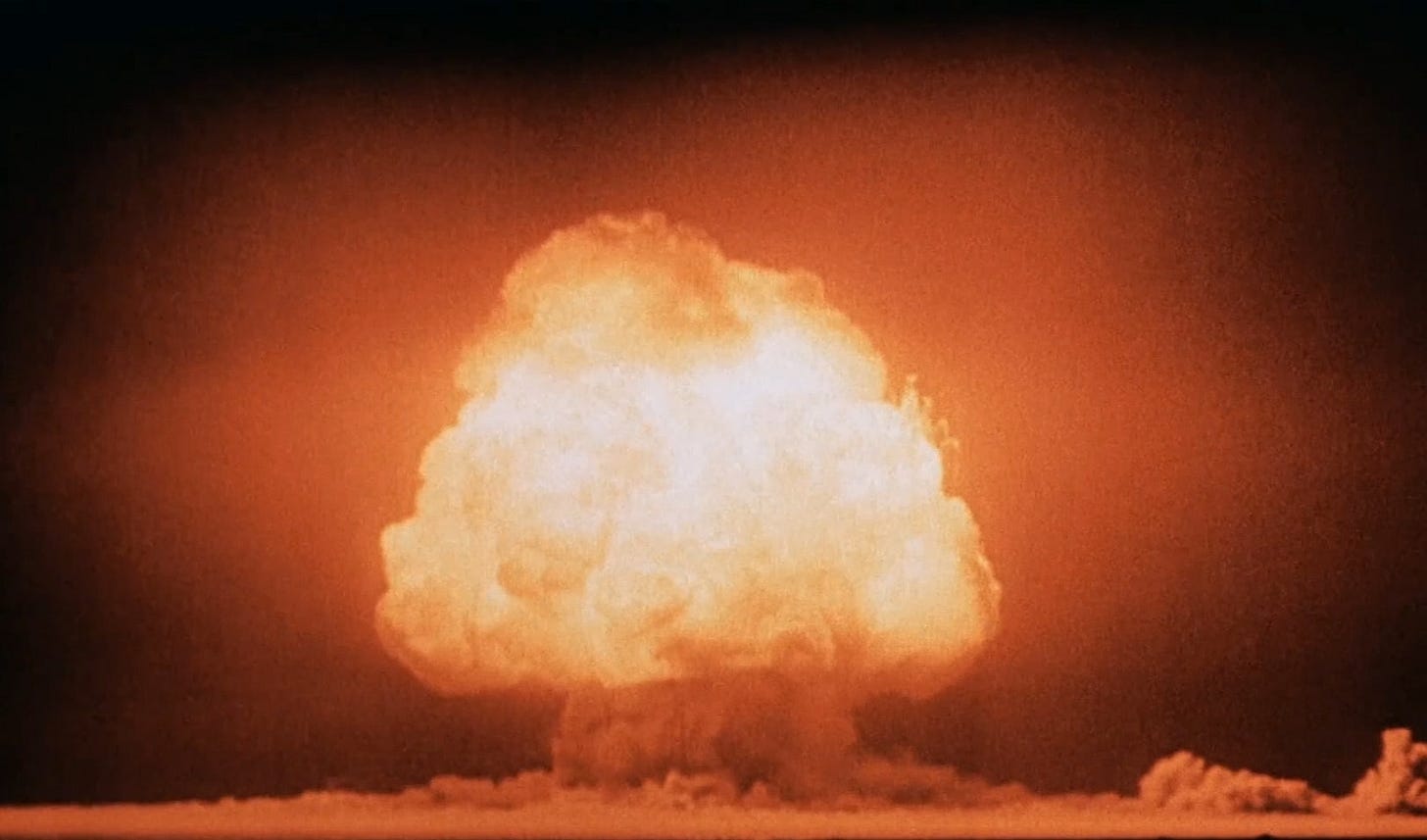Fallout from the Unholy Trinity Test: 80 Years Ago
First atomic test on July 16, 1945, and what was left out of "Oppenheimer."
Every year at this time I trace the final days leading to the first use of the atomic bomb against two cities, Hiroshima and Nagasaki, in August 1945. In this way the fateful, and in my view, tragic decisions made by President Truman, his advisers, and others, can be judged more clearly in "real time." As some know, this is a subject that I have explored in hundreds of articles, thousands of posts, and in four books, since 1984. Now my new film has started streaming on PBS, go here for easy links to watch now and read more in new book.
Here's today's entry on the summer of 1945. You can still subscribe to this newsletter for free.
While most people trace the dawn of the nuclear era to August 6, 1945, and the dropping of the atomic bomb over the center of Hiroshima, it really began three weeks earlier, in the desert near Alamogordo, New Mexico, with the top-secret Trinity test. Its 90rd anniversary will be marked—or mourned—tomorrow.
Entire books have been written about the test, so I’ll just touch on one key issue here briefly. It’s related to a hallmark of the age that would follow: a new government obsession with secrecy, which soon spread from the nuclear program to all military and foreign affairs in the cold war era.
In completing their work on building the bomb, Manhattan Project scientists knew it would produce deadly radiation but weren’t sure exactly how much. The military planners were mainly concerned about the bomber pilots catching a dose, but J. Robert Oppenheimer, “The Father of the Bomb,” worried, with good cause (as it turned out) that the radiation could drift a few miles and also fall to earth with the rain.
Indeed, scientists warned of danger to those living downwind from the Trinity site but, in a pattern-setting decision, the military boss, General Leslie Groves, ruled that residents not be evacuated and kept completely in the dark (at least until they spotted a blast brighter than any sun). Nothing was to interfere with the test. When two physicians on Oppenheimer’s staff (though not Oppie himself) proposed an evacuation, Groves replied, “What are you, Hearst propagandists?”
Admiral Williams Leahy, President Truman’s chief of staff—who opposed dropping the bomb on Japan—placed the bomb in the same category as “poison gas.” And, sure enough, soon after the shot went off before dawn on July 16, scientists monitored some alarming evidence. Radiation was quickly settling to earth in a band thirty miles wide by 100 miles long. A paralyzed mule was discovered twenty-five miles from ground zero.
Still, it could have been worse; the cloud had drifted over loosely-populated areas. “We were just damn lucky,” the head of radiological safety for the test later affirmed.
The local press knew nothing about any of this. When the shock wave had hit the trenches in the desert, Groves’ first words were: “We must keep the whole thing quiet.” This set the tone for the decades that followed, with tragic effects for “downwinders” and others tainted across the country, workers in the nuclear industry, “atomic soldiers,” those who questioned the building of the hydrogen bomb and an expanding arms race, among others.
Naturally, reporters were curious about the big blast, however, so Groves released a statement written by W.L. Laurence (who was on leave from the New York Times and playing the role of chief atomic propagandist) announcing that an ammunition dump had exploded. (Photo below: Oppie and Groves at the site several weeks later.)
In the weeks that followed, ranchers discovered dozens of cattle had odd burns or were losing hair. Oppenheimer ordered post-test health reports held in the strictest secrecy. (Of course, you did not see this, or anything related, in Nolan’s “Oppenheimer.”) When W.L. Laurence’s famous report on the Trinity test was published just after the Hiroshima bombing he made no mention of radiation at all.
Even as the scientists celebrated their success at Alamagordo on July 16, the first radioactive cloud was drifting eastward over America, depositing fallout along its path. When Americans found out about this, three months later, the word came not from the government but from the president of the Eastman Kodak Company in Rochester, New York, who wondered why some of his film was fogging and suspected radioactivity as the cause.
Fallout was absent in early press accounts of the Hiroshima bombing as the media joined in the triumphalist backing of The Bomb and the bombings. When reports of thousands in Hiroshima and Nagasaki afflicted with a strange and horrible new disease emerged, General Groves, at first, called it all a “hoax” and “propaganda” and speculated that the Japanese had different “blood.” Then the military kept reporters from the West from arriving in the atomic cities, until more than a month after the blasts, when it controlled access in an early version of today’s “embedded reporters” program.
When some of the truth about radiation started to surface in the U.S. media, a full-scale official effort to downplay the Japanese death toll—and defend the decision to use the bomb—really accelerated, leading to an effective decades-long “Hiroshima narrative.” But that’s a story for another day here.




Black Rain is the heartbreaking 1965 novel by Ibuse about the effects on civilians.
Thanks for bringing attention to this, to these important historical points. The development of the Secret State is a part of the fallout of the Manhattan Project.
A book I found most useful on this point is Gary Wills' 2010, "Bomb Power: The Modern Presidency and the National Security State".. He makes the argument that with such a powerful, and secret branch of government, we cannot have a true democracy, as the electorate will never know what's being done in our name: the Hydrogen Bomb, Iran, Guatemala, Vietnam, Chile, Cuba..